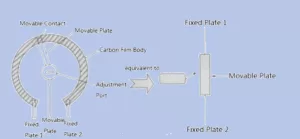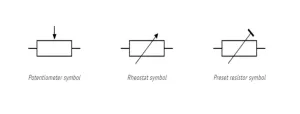
What is a Variable Resistor?
November 30 2023  1573
1573
Inquiry
Global electronic component supplier AMPHEO PTY LTD: Rich inventory for one-stop shopping. Inquire easily, and receive fast, customized solutions and quotes.
QUICK RFQ
ADD TO RFQ LIST
This blog aims to provide a comprehensive exploration of the fundamental principles and versatile applications of variable resistors, an essential component in electronic circuits.
What is a Variable Resistor?
A variable resistor, also known as a potentiometer, is an electronic component that allows the resistance in an electric circuit to be adjusted manually. It consists of a resistive element and a sliding contact (wiper) that can be moved along the resistive material. By changing the position of the wiper, the resistance between the wiper and the ends of the resistive element can be varied, thus altering the overall resistance of the component. Variable resistors are commonly used in electronic circuits to control the flow of electric current, adjust signal levels, or divide voltages. They are often found in audio equipment for volume control, in lighting systems for dimming control, and in many other applications where precise control of resistance is required. The resistance of a variable resistor can typically be adjusted by turning a knob, sliding a lever, or using some other manual mechanism. In summary, variable resistors are essential components in electronic circuits, providing a convenient means to adjust resistance and control electrical parameters. Their versatility and ease of use make them indispensable in various electronic applications, contributing to the functionality and performance of various devices and systems.
Types of Variable Resistor
Variable resistors come in various types, each designed for specific applications and requirements. Understanding the different types of variable resistors can help in selecting the most suitable component for a particular electronic circuit or system.- Rotary Potentiometers: Rotary potentiometers, also known as potentiometers or "pots," are one of the most common types of variable resistors. They have a circular form factor and are adjusted by rotating a knob. Rotary potentiometers are widely used for volume control in audio equipment, as well as for controlling parameters such as brightness and speed in various electronic devices. They are available in single-turn and multi-turn configurations, with multi-turn potentiometers offering finer adjustment resolution.
- Slide Potentiometers: Slide potentiometers, also called linear potentiometers, have a linear form factor and are adjusted by sliding a wiper along a straight track. These variable resistors are often used in applications where linear motion is more convenient, such as in mixing consoles, equalizers, and other audio equipment. Slide potentiometers are available in various travel lengths to accommodate different requirements.
- Trimmer Potentiometers: Trimmer potentiometers, also known as trim pots, are designed for more precise adjustments and are often used during the manufacturing or calibration of electronic devices. They are typically small, preset variable resistors that can be adjusted using a small screwdriver or a specialized tool. Trimmer potentiometers are commonly found on circuit boards and are used for fine-tuning parameters such as voltage levels, currents, and signal offsets.
- Digital Potentiometers: Digital potentiometers, or digits, are a modern alternative to traditional analog variable resistors. They are controlled digitally through serial communication interfaces such as I2C or SPI, allowing for remote and programmable adjustment of resistance. Digital potentiometers are often used in applications where precise digital control is required, such as in instrumentation, automated systems, and digital audio equipment.
Symbols for Variable Resistors
The figure below illustrates the IEC standard symbols for three types of variable resistors. These symbols are commonly used in circuit diagrams and schematics to represent rotary potentiometers, slide potentiometers, and trimmer potentiometers. Understanding these symbols is essential for accurately depicting variable resistors in electronic circuit diagrams and designs. The symbols provide a standardized representation that is universally recognized in the field of electrical and electronic engineering. Using these symbols, engineers and technicians can effectively communicate the presence and function of variable resistors within a circuit, facilitating clear and precise documentation and understanding of the circuit's operation.
How Does a Variable Resistor Work?
A variable resistor, also known as a potentiometer, operates by adjusting the amount of resistance in an electric circuit. It consists of a resistive element and a sliding contact (wiper) that can be moved along the resistive material. By changing the position of the wiper, the resistance between the wiper and the ends of the resistive element can be varied, thus altering the overall resistance of the component. When a variable resistor is connected in a circuit, the flow of electric current encounters the resistance provided by the resistive element. By adjusting the position of the wiper, the effective length of the resistive path through which the current flows can be changed. This, in turn, alters the total resistance experienced by the current. When the wiper is moved closer to one end of the resistive element, the resistance decreases, allowing more current to flow. Conversely, moving the wiper away from that end increases the resistance, restricting the flow of current. The mechanism by which a variable resistor works is based on the principle of Ohm's law, which states that the current flowing through a conductor between two points is directly proportional to the voltage across the two points and inversely proportional to the resistance between them. By adjusting the variable resistor's resistance, the circuit's voltage and current can be controlled, allowing for precise adjustments in signal levels, current flow, or voltage division. Variable resistors are commonly used in electronic circuits to control parameters such as volume, brightness, speed, and other electrical characteristics. Their ability to adjust resistance manually makes them versatile components in a wide range of applications. Whether in audio equipment, lighting systems, or precision instrumentation, the operation of a variable resistor enables the fine-tuning of electrical parameters to meet specific requirements, contributing to the functionality and performance of electronic devices and systems.Applications for Variable Resistors
Variable resistors find diverse applications across various fields due to their ability to control and adjust electrical parameters. Their versatility makes them indispensable in various electronic devices and systems. One of the most common applications of variable resistors is in audio equipment. Rotary potentiometers are frequently used for volume control in amplifiers, radios, and other audio devices. By adjusting the resistance, users can precisely control the volume level, providing a convenient and intuitive way to manage audio output. Additionally, variable resistors are used in equalizers and tone controls, allowing users to adjust the frequency response and tailor the audio output to their preferences. In lighting systems, variable resistors play a crucial role in dimmer switches. By incorporating a variable resistor into the circuit, the intensity of the light can be adjusted smoothly, providing ambient lighting control in homes, offices, theaters, and other environments. This allows users to create different lighting atmospheres and conserve energy by dimming the lights when full brightness is not required. Variable resistors are also utilized in control systems for motor speed regulation. By adjusting the resistance in the motor circuit, the speed of the motor can be controlled, enabling precise speed adjustments in applications such as fans, conveyor belts, and industrial machinery. This contributes to energy efficiency and allows for tailored operations based on specific requirements. In electronic instrumentation and testing equipment, trimmer potentiometers are used for calibration and fine-tuning. These precision variable resistors enable technicians and engineers to adjust voltage levels, currents, and signal offsets with high accuracy, ensuring the proper functioning and calibration of electronic devices and systems. Furthermore, variable resistors are employed in user interfaces and control panels, providing manual adjustment for parameters such as temperature, pressure, and flow rate in various industrial and consumer devices. Their ease of use and ability to provide precise control make them essential components in a wide array of applications.Conclusion
In summary, the applications for variable resistors are diverse and encompass audio control, lighting regulation, motor speed adjustment, calibration in instrumentation, and user interface control. Their ability to adjust resistance and control electrical parameters makes them essential components in electronic circuits, contributing to the functionality, performance, and user experience of numerous devices and systems.Populer Posts
5SGSMD8K3F40C2LG
Intel
LCMXO3D-9400ZC-2BG256C
Lattice Semiconductor Corporation
5AGXBB1D4F40I5G
Intel
M1A3P400-FGG144I
Microchip Technology
A3PN125-1VQ100I
Microchip Technology
EP4CE40F29I8L
Intel
EP2AGX45DF29I5G
Intel
5CEFA4U19C6N
Intel
A42MX36-2PQG208
Microchip Technology
OR2C15A3S240I-DBA1357
Lattice Semiconductor Corporation
EP4SGX290FH29C2XG
Intel
5CGXFC4C6F23I7N
Intel
